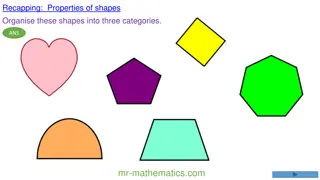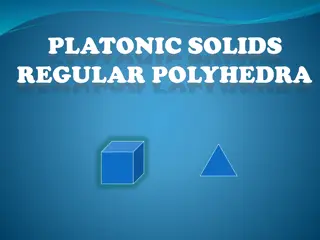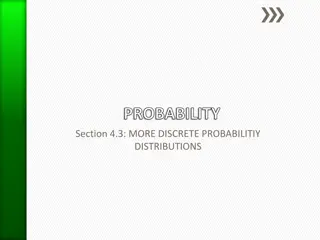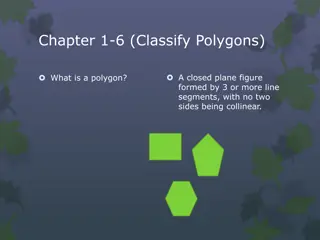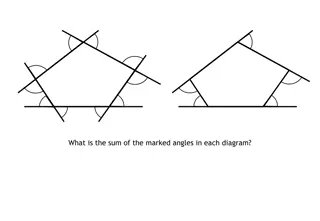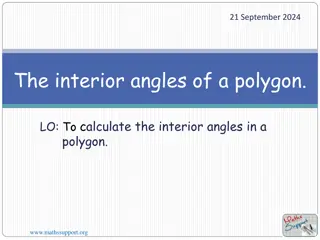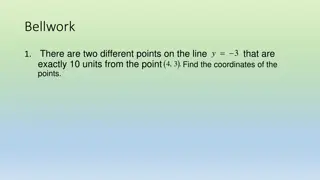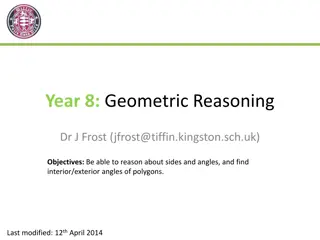Area Relationships in Geometric Polygons
Delve into the area relationships of polygons by analyzing dots on the perimeter and interior of various shapes, leading to deductions about area formulas and potential linear relationships. Discover insights through practical experiments and mathematical hypotheses.
Uploaded on Nov 27, 2024 | 0 Views
Download Presentation

Please find below an Image/Link to download the presentation.
The content on the website is provided AS IS for your information and personal use only. It may not be sold, licensed, or shared on other websites without obtaining consent from the author.If you encounter any issues during the download, it is possible that the publisher has removed the file from their server.
You are allowed to download the files provided on this website for personal or commercial use, subject to the condition that they are used lawfully. All files are the property of their respective owners.
The content on the website is provided AS IS for your information and personal use only. It may not be sold, licensed, or shared on other websites without obtaining consent from the author.
E N D
Presentation Transcript
Pick a Polygon Discover Pick s Theorem Areas have different shapes but the same area.
SIC_43 Pick a Polygon A B C a D E
Work out the area (?) of each polygon. For each polygon record the number of dots on its perimeter (?) and the number of dots in its interior (?). (Be careful: you must ensure that a dot on an edge really is on the edge check using gradients.) Record these values in a table. Pick a polygon and move one or more of its vertices and see what happens to these values. See if you can find a relationship between ?, ? and ?. (You may wish to draw more polygons to obtain more data.) Polygon Dots on Perimeter (?) Dots in Interior (?) Area (?) A B C D E 4 4 5 8 5 8 8 7 10 12 6 11 16 5 12
Lets look at how the area changes with the number of dots on the perimeter. ? =1 ? = 3,? = 0 2 ? = 4,? = 0 ? = 1 ? =3 ? = 5,? = 0 2 We can see that this trend will continue and deduce that as the number of dots on the perimeter increases by one the area increases by one half.
Lets now look at how the area changes with the number of dots in the interior. ? = 6,? = 0 ? = 2 ? = 6,? = 1 ? = 3 ? = 6,? = 2 ? = 4 We can see that this trend will continue and deduce that as the number of dots in the interior increases by one the area increases by one.
1 2? + ? 3 2 Consolidating results: ? =1 = A + 1 ? = 3,? = 0 2 ? = 4,? = 0 ? = 1 = A + 1 2 ? =3 5 2 = A + 1 ? = 5,? = 0 2 = A + 1 ? = 6,? = 0 ? = 2 3 = A + 1 ? = 6,? = 1 ? = 3 4 = A + 1 ? = 6,? = 2 ? = 4 5 So we can deduce that a formula for the area of each polygon is: ? =1 2? + ? 1 Note: although we can feel confident about this formula we have not proved it.
Or, you could decide that there may be a linear relationship between the quantities and investigate by solving some simultaneous equations. Let s assume ?? + ?? + ? = ? and form equations from the 4? + 4? + ? = 5 8? + 5? + ? = 8 8? + 7? + ? = 10 first three results: (1) (2) (3) Polygon Dots on Perimeter (?) Dots in Interior (?) Area (?) A B C 4 4 5 8 5 8 8 7 10
Or, you could decide that there may be a linear relationship between the quantities and investigate by solving some simultaneous equations. Let s assume ?? + ?? + ? = ? and form equations from the 4? + 4? + ? = 5 8? + 5? + ? = 8 8? + 7? + ? = 10 first three results: (1) (2) (3) = 3 = 5 (2)-(1) (4) 4? + ? (3)-(1) (5) 4? + 3? = 2 (5)-(4) 2? 4? + 1 ? = 1 = 3 (4) ? =1 2 + 4 + ? = 5 ? = 1 2 (1) ? =1 So 2? + ? 1 as before.
Pick a Polygon Key: = 1 The polygons shown go through 80 Points. What is the value of the shaded area?
Pick a Polygon Add an edge, as shown, forming a single polygon with two sides that happen to overlap. This makes no difference to the area and the equation remains valid. But we have added two extra points on the perimeter. There are no interior points. So area = 1 280 + 2 + 0 1 = 40. The polygons shown go through 80 Points. What is the value of the shaded area?
SIC_43 Pick a Polygon A B C a D E
Work out the area (?) of each polygon. For each polygon record the number of dots on its perimeter (?) and the number of dots in its interior (?). (Be careful: you must ensure that a dot on an edge really is on the edge check using gradients.) Record these values in a table. Pick a polygon and move one or more of its vertices and see what happens to these values. See if you can find a relationship between ?, ? and ?. (You may wish to draw more polygons to obtain more data.) Polygon Dots on Perimeter (?) Dots in Interior (?) Area (?) A B C D E
SIC_43 Pick a Polygon A B C D b E
Work out the area (?) of each polygon. For each polygon record the number of dots on its perimeter (?) and the number of dots in its interior (?). (Be careful: you must ensure that a dot on an edge really is on the edge check using gradients.) Record these values in a table. Pick a polygon and move one or more of its vertices and see what happens to these values. See if you can find a relationship between ?, ? and ?. (You may wish to draw more polygons to obtain more data.) Polygon Dots on Perimeter (?) Dots in Interior (?) Area (?) A B C D E
SIC_43 Pick a Polygon A B C c D E
Work out the area (?) of each polygon. For each polygon record the number of dots on its perimeter (?) and the number of dots in its interior (?). (Be careful: you must ensure that a dot on an edge really is on the edge check using gradients.) Record these values in a table. Pick a polygon and move one or more of its vertices and see what happens to these values. See if you can find a relationship between ?, ? and ?. (You may wish to draw more polygons to obtain more data.) Polygon Dots on Perimeter (?) Dots in Interior (?) Area (?) A B C D E
SIC_43 Pick a Polygon A B C D d E
Work out the area (?) of each polygon. For each polygon record the number of dots on its perimeter (?) and the number of dots in its interior (?). (Be careful: you must ensure that a dot on an edge really is on the edge check using gradients.) Record these values in a table. Pick a polygon and move one or more of its vertices and see what happens to these values. See if you can find a relationship between ?, ? and ?. (You may wish to draw more polygons to obtain more data.) Polygon Dots on Perimeter (?) Dots in Interior (?) Area (?) A B C D E
SIC_43 Pick a Polygon B A C D e E
Work out the area (?) of each polygon. For each polygon record the number of dots on its perimeter (?) and the number of dots in its interior (?). (Be careful: you must ensure that a dot on an edge really is on the edge check using gradients.) Record these values in a table. Pick a polygon and move one or more of its vertices and see what happens to these values. See if you can find a relationship between ?, ? and ?. (You may wish to draw more polygons to obtain more data.) Polygon Dots on Perimeter (?) Dots in Interior (?) Area (?) A B C D E
SIC_43 Pick a Polygon B A C D f E
Work out the area (?) of each polygon. For each polygon record the number of dots on its perimeter (?) and the number of dots in its interior (?). (Be careful: you must ensure that a dot on an edge really is on the edge check using gradients.) Record these values in a table. Pick a polygon and move one or more of its vertices and see what happens to these values. See if you can find a relationship between ?, ? and ?. (You may wish to draw more polygons to obtain more data.) Polygon Dots on Perimeter (?) Dots in Interior (?) Area (?) A B C D E
SIC_43 Pick a Polygon Key: = 1 The polygons shown go through 80 Points. What is the value of the shaded area?
SIC_43 Pick a Polygon Key: = 1 The polygons shown go through 80 Points. What is the value of the shaded area?
SIC_43 Pick a Polygon Key: = 1 The polygons shown go through 80 Points. What is the value of the shaded area?
SIC_43 Pick a Polygon Key: = 1 The polygons shown go through 80 Points. What is the value of the shaded area?
SIC_43 Pick a Polygon Key: = 1 The polygons shown go through 80 Points. What is the value of the shaded area?
SIC_43 Pick a Polygon Key: = 1 The polygons shown go through 80 Points. What is the value of the shaded area?
PROOF There is a decent proof in Wikipedia: https://en.wikipedia.org/wiki/Pick%27s_theorem
Pick a Polygon (4,4) 5
Pick a Polygon (8,5) 8
Pick a Polygon (8,7) 10
Pick a Polygon (12,6) 11
Pick a Polygon (16,5) 12






